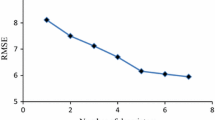Abstract
In this work, physical properties of sulfur compounds (critical temperature (T c ), critical pressure (P c ), and Pitzer’s acentric factor (ω)) are predicted using quantitative structure–property relationship technique. Sulfur compounds present in petroleum cuts are considered environmental hazards. Genetic algorithm based multivariate linear regression (GA-MLR) is used to select most statistically effective molecular descriptors on the properties. Using the selected molecular descriptors, feed forward neural networks (FFNNs) are applied to develop some molecular-based models to predict the properties. The presented models are quite accurate and can be used to predict the properties of sulfur compounds.
Similar content being viewed by others
References
Mohammadbeigi K, Tajerian M (2004) Demercaptanization of distillate (DMD). Petrol Coal 46: 17–22
Zaykina RF, Zaykin YA, Mamonova TB, Nadirov NK (2002) Radiation methods for demercaptanization and desulfurization of oil products. Radiat Phys Chem 63: 621–624 doi:10.1016/S0969-806X(01)00654-5
Farhat AM, Al-Malki A, El-Ali B, Martinie GN, Siddiqui M (2006) Deep desulphurization of gasoline and diesel fuels using non-hydrogen consuming techniques. Fuel 85: 1354–1363 doi:10.1016/j.fuel.2005.12.006
Ito E, van Veen JAR (2006) On novel processes for removing sulfur from refinery streams. Catal Today 116: 446–460 doi:10.1016/j.cattod.2006.06.040
UOP company website, http://www.uop.com
Joback KG (1984) A unified approach to physical property estimation using multivariate statistical techniques. S.M. Thesis, Department of Chemical Engineering, Massachusetts Institute of Technology, Cambridge, MA
Joback KG, Reid RC (1987) Estimation of pure-components properties from group-contributions. Chem Eng Commun 57: 233–243 doi:10.1080/00986448708960487
Constantinou L, Gani R (1994) New group contribution method for estimating properties of pure components. AIChE J 40: 1697–1710 doi:10.1002/aic.690401011
Wilson GM, Jasperson LV (1996) Critical constants 7, P c , estimation based on zero, first and second order methods. AIChE Spring Meeting, New Orleans, LA
Marrero-Marejón J, Pardillo-Fontdevila E (1999) Estimation of pure compound properties using group-interaction contributions. AIChE J 45:615–621. doi:10.1002/aic.690450318
Poling BE, Prausnitz JM, O’Connell JP (2000) The properties of gases and liquids. McGraw-Hill, New York
Katritzky AR, Fara DC (2005) How chemical structure determines physical, chemical, and technological properties: an overview illustrating the potential of quantitative structure–property relationships for fuels science. Energy Fuels 19: 922–935 doi:10.1021/ef040033q
Project 801, Evaluated process design data, public release documentation. Design Institute for Physical Properties (DIPPR), American Institute of Chemical Engineers (AIChE), 2006
Todeschini R, Consonni V (2000) In: Manhold R, Kubinyi H, Temmerman H (Series editors), Handbook of molecular descriptors. Weinheim, Wiley-VCH
Talete srl, Dragon for Widows (Software for molecular descriptor calculation). Version 5.4-2006- http://www.talete.mi.it/
Hyperchem Release 7.5 for Windows, Molecular modeling system. Hypercube Inc., 2002
Leardi R, Boggia R, Terrile M (1992) Genetic algorithms as a strategy for feature selection. J Chemometr 6: 267–281 doi:10.1002/cem.1180060506
Gharagheizi F (2007) QSPR analysis for intrinsic viscosity of polymer solutions by means of GA-MLR and RBFNN. Comput Mater Sci 40: 159–167 doi:10.1016/j.commatsci.2006.11.010
Gharagheizi F (2007) A new accurate neural network quantitative structure–property relationship for prediction of θ (lower critical solution temperature) of polymer solutions. e-Polymers, Article Number 114
Gharagheizi F (2008) A simple equation for prediction of net heat of combustion of pure chemicals. Chemometr Intell Lab 91: 177–180 doi:10.1016/j.chemolab.2007.11.003
Gharagheizi F (2008) A new molecular-based model for prediction of enthalpy of sublimation of pure components. Thermochim Acta 469: 8–11 doi:10.1016/j.tca.2007.12.005
Gharagheizi F, Alamdari RF (2008) A molecular-based model for prediction of solubility of C60 ullerene in various solvents. Fuller Nanotub Car N 16: 40–57 doi:10.1080/15363830701779315
Gharagheizi F (2008) QSPR studies for solubility parameter by means of genetic algorithm-based multivariate linear regression and generalized regression neural network. QSAR Comb Sci 27: 165–170 doi:10.1002/qsar.200630159
Gharagheizi F, Alamdari RF (2008) Prediction of flash point temperature of pure components using a quantitative structure–property relationship model. QSAR Comb Sci 27: 679–683 doi:10.1002/qsar.200730110
Gharagheizi F, Fazeli A (2008) Prediction of the Watson characterization factor of hydrocarbon components from molecular properties. QSAR Comb Sci 27: 758–767 doi:10.1002/qsar.200730020
Gharagheizi F, Mehrpooya M (2007) Prediction of standard chemical exergy by a three descriptors QSPR model. Energy Convers Manage 48: 2453–2460 doi:10.1016/j.enconman.2007.04.005
Gharagheizi F (in press) A quantitative structure–property relationship for prediction of lower flammability limit percent of pure compounds, Energ Fuel. doi:101021/ef800375b
Vatani A, Mehrpooya M, Gharagheizi F (2007) Prediction of standard enthalpy of formation by a QSPR model. Int J Mol Sci 8:407–432
Sattari M, Gharagheizi F (2008) Prediction of molecular diffusivity of pure components into air: a QSPR approach. Chemosphere 72: 1298–1302 doi:10.1016/j.chemosphere.2008.04.049
Todeschini R, Consonni V, Maiocchi A (1999) The K correlation index: theory development and its application in chemometrics. Chemometr Intell Lab 46: 13–29 doi:10.1016/S0169-7439(98)00124-5
Taskinen J, Yliruusi J (2003) Prediction of physicochemical properties based on neural network modeling. Adv Drug Deliv Rev 55: 1163–1183 doi:10.1016/S0169-409X(03)00117-0
Karelson M, Dobchev AD, Kulshyn OV, Katritzky AR (2006) Neural networks convergence using physicochemical data. J Chem Inf Model 46: 1891 doi:10.1021/ci0600206
Gharagheizi F, Alamdari RF, Angaji MT (2008) A neural network-group contribution method for estimation of flash point temperature of pure compounds. Energy Fuels 22: 1628–1635 doi:10.1021/ef700753t
Author information
Authors and Affiliations
Corresponding author
Rights and permissions
About this article
Cite this article
Gharagheizi, F., Mehrpooya, M. Prediction of some important physical properties of sulfur compounds using quantitative structure–properties relationships. Mol Divers 12, 143–155 (2008). https://doi.org/10.1007/s11030-008-9088-6
Received:
Accepted:
Published:
Issue Date:
DOI: https://doi.org/10.1007/s11030-008-9088-6




